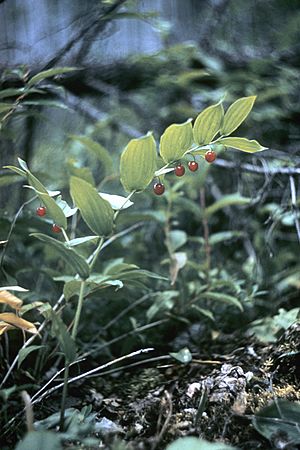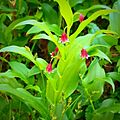Rose twisted stalk facts for kids
Quick facts for kids Rose twisted stalk |
|
|---|---|
 |
|
| Conservation status | |
| Scientific classification | |
| Genus: |
Streptopus
|
| Species: |
lanceolatus
|
| Synonyms | |
|
|
Streptopus lanceolatus, also known as rose twisted stalk or rosybells, is a cool plant found in North American forests. It's a perennial plant, which means it lives for more than two years. You can find it from Alaska all the way to Labrador, and south through the Great Lakes and Appalachian Mountains in the United States. It also grows in Montana, Washington state, Oregon, and St. Pierre & Miquelon. This plant loves cool, slightly acidic soils and grows well in mixed-wood forests.
Contents
What Does Rose Twisted Stalk Look Like?
Plant Structure and Leaves
The rose twisted stalk grows from a rhizome, which is like an underground stem. It can also grow from a seed. Its main stem has a unique zigzag shape. Sometimes it branches out, and sometimes it grows straight up without branches.
This plant can grow up to 30 centimeters (about 12 inches) tall. It has leaves that grow one after another along the stem. These leaves are wide and shaped like a lance or an oval. They have pointed tips and a rounded base, and they don't have stalks connecting them to the stem. Often, the edges of the leaves are slightly toothed, and you might find fine hairs on the veins on the underside of the leaves.
Flowers and Berries
The beautiful bell-shaped flowers of the rose twisted stalk appear in early summer, usually from May to July. Each flower grows by itself, opposite a leaf. They hang down on stalks that are about 1 to 3 centimeters (0.4 to 1.2 inches) long and bend in the middle.
Each flower has six petals that are usually rose-colored or white, often with purple streaks. These petals curve backward. After the flowers, the plant produces an elongated red berry. These berries ripen in mid-summer, around July or August. It's important to know that eating too many of these berries can cause an upset stomach.
How to Identify Rose Twisted Stalk
It's easy to tell Streptopus lanceolatus apart from other similar plants like Solomon's seal and false Solomon's seal. The main way to identify it is by its zigzag stem and the way its leaves grow alternately along the stem. This unique zigzag pattern is a key feature!
Images for kids
-
Streptopus lanceolatus in bloom, picture taken on Dude Mountain Trail in Alaska



